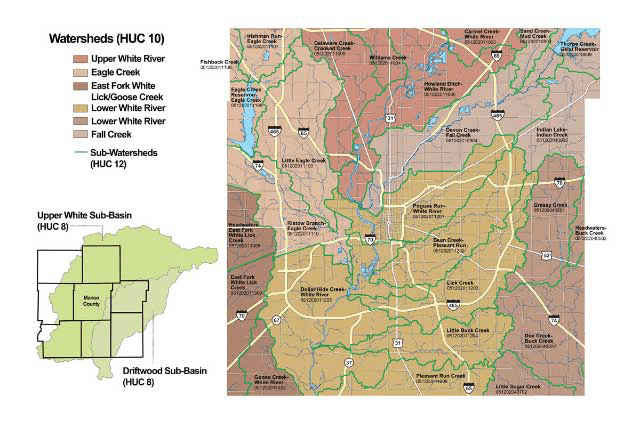Watersheds
What is a watershed?
A watershed is the area of land where all of the water that is under it, or drains off of it, goes to the same place. A watershed carries water “shed” from the land after rain falls and snow melts. Drop by drop, water is channeled into soils, ground waters, ditches, creeks, and streams, making its way to larger rivers and eventually the sea.
“When we try to pick out anything by itself, we find it hitched to everything else in the universe” – John Muir
Watersheds of Marion County

Watershed Organizations in Marion County
A number of watershed community organizations have formed to work together on water quality issues in Marion County. We hope you will become involved in your local watershed to assist their efforts in improving watershed management and your water quality. Some of these organizations offer cost share programs for a limited time to help you install water quality projects on your property such as rain gardens, bioswales, rain barrels and pervious pavement. Programs target specific watershed locations so contact the organization to see if you qualify for cost share dollars.
- White River Watershed Alliance
- Eagle Creek Watershed Alliance
- Lower Fall Creek Watershed
- Upper Fall Creek / Geist Reservoir Watershed Alliance
- Pleasant Run Watershed
Reconnecting to Our Waterways
Reconnecting to Our Waterways (ROW) is a grassroots movement that is helping neighbors strengthen waterways; and in turn, helping waterways strengthen neighborhoods.
It is a coalition of Indianapolis neighborhoods and residents, public and private organizations, and civic leaders, led by a public-private partnership of many business and nonprofit organizations. ROW actively seeks input from the residents and stakeholders who live and work closest to the waterways. Learn more about how to get engaged and finding out more about this group.
See more! Video skit about Marion County waterways.
Which watershed do you live in?
Watersheds in Central Indiana and Marion County
Most waterways in Marion County are part of The Upper White River Watershed which encompasses a 2,720 square mile area (approx. 1.7 million acres) within central Indiana. The Upper White River Watershed extends across sixteen (16) counties including significant portions of Hancock, Marion, Hendricks, Johnson, Hamilton, Morgan, Boone, Tipton, Madison, Henry, Delaware, and Randolph Counties, as well as smaller portions of Owen, Monroe, Brown and Clinton Counties.
The Upper White River Watershed is broken down in Marion County into smaller sub-watersheds: Eagle Creek, Lower Fall Creek, Upper Fall Creek/Geist Reservoir, Pleasant Run – White River, White Lick Creek,Goose Creek–White River, Crooked Creek-White River, and Clear Creek-White River. The extreme eastern and southeastern corner ofMarionCountyis in the Driftwood River Watershed which is broken down into the Grassy Creek,BuckCreekand the Little Sugar Creek sub-watersheds. Watersheds are also known by their Hydrologic Unit Code or HUC.
“Children learn about their place in the world—their street address, city, and zip code at a very early age. But there is another important dimension to our lives that is also important to our sense of place — our watershed or ecological address. The future of the planet and the protection of the nation’s water resources depend on a universal understanding and appreciation of watersheds”.
“Everyone—whether we live on a farm, in a city, or on the coast—lives in a watershed, and we all have an impact on its health. Some watersheds are small and drain just a few acres of land. Others, such as the Chesapeake Bay, are expansive estuaries where the rivers meet the sea. And then there’s the Mississippi River watershed which feeds the nation’s fertile cropland and drains two-thirds of the United States before emptying into the Gulf of Mexico. Watersheds supply drinking water, provide recreation and respite, and sustain life.”
“The first step to creating and sustaining healthy and livable communities is understanding one’s place in the big global picture. Kids can grasp this simple, powerful concept at an early age, but it needs to be universally embraced by all citizens to make a lasting change in our world and our environment for today’s and future generations.”
* The above passages were taken from an Environmental Protection Agency (EPA) article titled, Building Livable Communities Starts with a Watershed Address.
The importance of watershed planning
When water flows across the land during rainfall events, it can carry fertilizers, loose soil, litter and other pollutants into streams and other surrounding water bodies. As a result, everything we do on the land affects the quality and quantity of our water resources and the natural systems that surround us. Therefore, the natural resources and the quality of life in our communities are directly affected—positively or negatively—by the way we plan for and manage the land we use.
Community watershed management planning is a way to consider a wide range of environmental, economic, and social issues along with the community’s vision for the future of the watershed under a single framework. Working within physical boundaries rather than political boundaries, the watershed management planning process provides opportunities to address water quality and habitat issues beyond the scope of single jurisdictions. It provides a means to ensure environmental protection, to support quality of life issues, and accommodates economic development using the watershed as the planning framework. Any kind of planning allows you to put a single action into the context of a larger vision—watershed management planning allows for that vision to include healthy natural resources and waterways.
Local governments and watershed associations play an essential role in restoring Marion County’s water resources through the restoration and protection of local water bodies and habitat. Many local agencies are becoming more engaged in watershed management planning. Because these entities have developed an understanding of the connection between land use and environmental health, it is hoped that watershed planning will become an integral part of comprehensive land use planning within their jurisdictions. Localities in the Marion County area have begun to conduct watershed management planning in areas such as Eagle Creek, Lower Fall Creek and the Upper Fall Creek/Geist Reservoir Watersheds.


